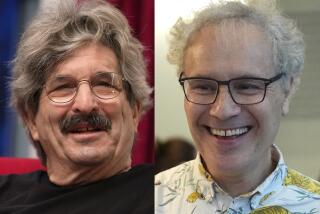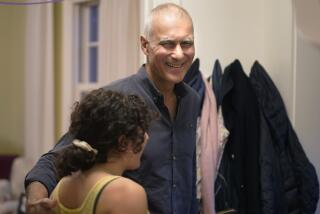Julius Axelrod, 92; Shared Nobel Prize for Findings on Brain Cells
- Share via
Julius Axelrod, the scientist who shared the Nobel Prize in medicine in 1970 for his work in explaining how brain cells communicate with one another, has died. He was 92.
Axelrod died in his sleep Wednesday at his home in Rockville, Md., according to the National Institute of Mental Health, where Axelrod worked for much of his life. The cause of death was not reported. He had experienced heart trouble in recent years.
Axelrod shared the Nobel in 1970 with Britain’s Bernard Katz and Sweden’s Ulf von Euler for their work on the way chemicals released by nerve endings in the brain affect human behavior. For his part, Axelrod explained how neurotransmitters in the brain communicate with nerve cells to regulate a wide range of automatic responses, including digestion, heartbeat and blood flow.
The scientists’ work had huge implications for pharmacology, including clearing the way for the development of selective serotonin reuptake inhibitors. Those drugs are now commonly used to treat depression and have such recognizable names as Zoloft, Paxil and Prozac.
“His contribution to the fields of mental health and neuroscience makes possible current breakthroughs on mood and anxiety disorders and myriad other areas,” Dr. Thomas R. Insel, director of the National Institute of Mental Health, said in a statement.
Axelrod’s career in science involved a slow maturation and a bit of luck.
He was born May 12, 1912, on the Lower East Side of New York City. His parents were Jewish immigrants from what is now Poland and his father made a living as a basket maker.
Axelrod graduated with a biology degree from City College of New York. He yearned to be a doctor, but the strict quotas on Jewish students -- and what he later conceded were less than stellar grades in some subjects -- kept him out of medical school.
Coming of age during the Depression, he needed work and was offered two opportunities: as a postal clerk or a lab technician.
For more than a decade, he worked at the New York City Department of Health testing the potency of vitamins added to foods. He lost the use of his left eye, which kept him out of the service during World War II, in the late 1930s when a bottle of ammonia exploded. For the remainder of his life, he would wear a darkened lens over the left eye of his glasses.
While conducting vitamin research during the day, Axelrod went to school at night to earn his master’s degree in chemistry from New York University.
Axelrod’s career took a fateful turn in 1945, when he was offered a job by noted pharmacologist Bernard Brodie at New York University’s Goldwater Memorial Hospital.
Their most significant work together was in analgesic medications. In the late 1940s, they wrote two influential papers that identified a new substance called acetaminophen as the key chemical inducing pain relief in such medicines. Their discovery was developed later as Tylenol.
Though he would forever view Brodie as his mentor, Axelrod decided to move on and, in 1949, joined what is now the National Heart, Lung and Blood Institute, where he studied the metabolism of caffeine, amphetamines, ephedrine and narcotics. He also discovered that a new class of liver enzymes held the key to metabolizing certain drugs.
But without a PhD, advancement was difficult. At the age of 41, he took a year’s leave of absence and went to George Washington University for the degree.
After receiving his doctorate in 1955, he signed on as chief of the pharmacology section at NIMH’s Laboratory of Clinical Science.
In 1993, Axelrod told a writer for Washingtonian magazine that his career path would not be possible today. “There’s not room in the field of research for people like me, who matured slowly.”
He retired in 1984 but stayed active at the NIMH for another decade, often coming in three times a week as a guest researcher. He was an emeritus scientist there.
“His magic was not in doing experiments that required lots of technical finesse,” co-worker and friend Dr. Michael J. Brownstein, said in a statement released by the NIMH. “It was in doing work that anyone could have done -- if they’d had the ideas. What separates the giants from the rest of us is the capacity to ask great questions.”
Axelrod’s wife of 54 years, Sally Taub, died in 1992. He is survived by two sons and three grandchildren.






